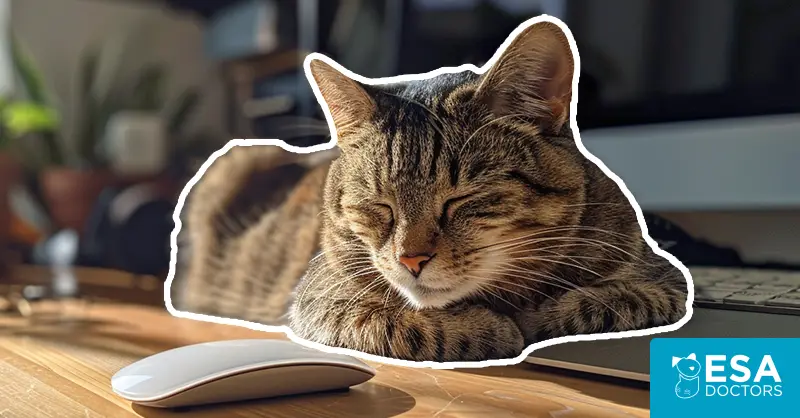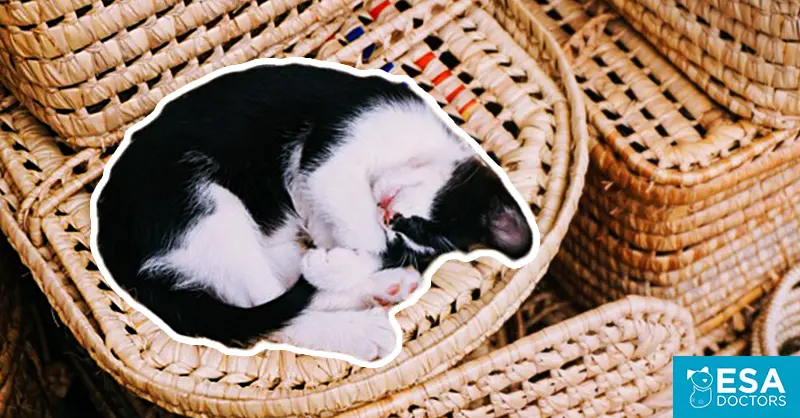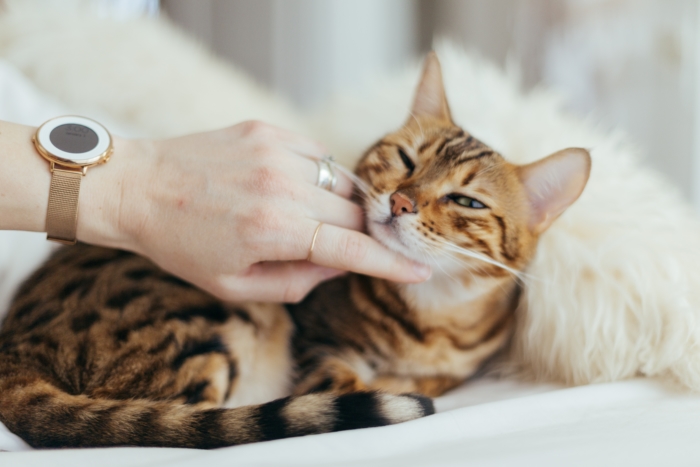Your ESA cat is more than just your support animal; they’re your way of helping naturally alleviate some of the debilitating effects anxiety can have.
Multiple studies, like this one from the NIH and this article from Cleveland Clinic, show that certain smells can reduce stress and anxiety. This can be one benefit to many ESA owners. The same holds true for petting your cat or dog for 10 minutes, according to Cornell University.
So it makes sense that spending quality time — even just a small break — with your emotional support cat can reduce anxiety and help you get back to work or fall asleep.
From sensory signals like kitty belly smell (you know what we’re talking about) to tactical touching (including making biscuits or purring in your ear) or even distractions like chasing lasers, here are 4 tips to help train your cat to engage and reduce your anxiety when you need them most.
Cuddling Against You
There’s nothing nicer than your cat cuddling against you when you need to lie down. Your senses fully engage by petting them, smelling their scent, and listening to their purrs.
Our tip here is to infuse the area where you want your cat to lie down with you with a scent they love. A catnip spray could be a good start. Make sure to test a tiny bit of the spray on a corner of your sheet or blanket to make sure it doesn’t stain or hurt the fabric.
Show your cat the bottle and then spray the spot while they watch. Once you have sprayed it, place the kitty there and pet them while saying a word the cat can associate with you spraying that spot. This way, you can begin using that word and encourage their response of jumping to the snuggle spot.
Needing to Smell and Sense Them
If smelling your cat helps reduce your anxiety, which is caused by work, this next tip may help.
Interesting fact: Psychology Today published this article that shows that 53 dog owners were able to pick their dogs out of a lineup based on smell alone.
We couldn’t find studies where they tested on cats, but you, as the owner, already know your cat’s unique scent, and this same theory likely holds true. Smelling your furbaby may have a calming effect that reduces some of the symptoms of anxiety.
Add a box or container by your computer for your cat to lay in. Kitty will love being near you, and it may keep them from pawing and clawing at your fingers while you type. If there isn’t room or they’re not interested in the box, test a small cat tree that can be placed next to your desk, or add a barstool with a pad and some catnip spray next to your office chair.
Get Petting Time In
It’s no secret that cats love lying in the sun! If one of your anxiety release mechanisms is petting your cat, you can encourage them to give some petting time by creating a sunny spot. There are a few things you can try.
- Buy a sun or heat lamp and place it in the area where you want the cat to lie.
- Try a heated blanket or pad that is child-safe and not easy for a cat to claw up or rip. You want it to be kitty-safe!
Now, let the cat experience the warmth of the heated object. You may want to try placing the lamp over a box or container they snuggle in or put the heating pad inside — as long as it is safe and not a fire hazard. Your cat will love the warm and comfy spot, and as they relax you can get your petting time in.
Making Biscuits and Laying on Top of You
There are other types of tactile treatments kitties can help with, like making biscuits on your stomach or chest, but these behaviors have to come naturally. Pay attention to the materials your cat responds behaviorally to; maybe a fleece blanket is better than a down blanket for making biscuits. If you want to encourage biscuit-making, use that blanket and encourage them to come over.
Sometimes, the combination of the blanket and a couple of treats in the area you want them to knead will create the desired response. As a thank you, you may also get some nice head bumps and rubs.
There’s no denying that cats can reduce anxiety, which is one reason they’re some of the top emotional support animals. If you’d like more information on ESAs and cats, join our newsletter by entering your email below.





Leave a Comment